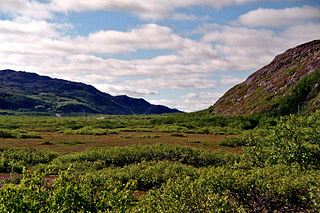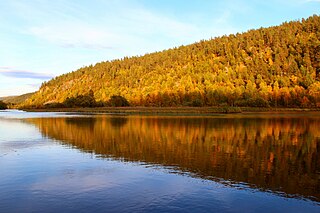Pasvik–Inari Trilateral Park is a continuously protected wilderness area in Finland, Norway and Russia. It consists of the Vätsäri Wilderness Area in Finland, Øvre Pasvik National Park and Øvre Pasvik Landscape Protection Area in Norway and the joint Norwegian–Russian Pasvik Nature Reserve.

Finland, officially the Republic of Finland, is a country in Northern Europe bordering the Baltic Sea, Gulf of Bothnia, and Gulf of Finland, between Norway to the north, Sweden to the northwest, and Russia to the east. Finland is a Nordic country and is situated in the geographical region of Fennoscandia. The capital and largest city is Helsinki. Other major cities are Espoo, Vantaa, Tampere, Oulu and Turku.

Norway, officially the Kingdom of Norway, is a Nordic country in Northern Europe whose territory comprises the western and northernmost portion of the Scandinavian Peninsula; the remote island of Jan Mayen and the archipelago of Svalbard are also part of the Kingdom of Norway. The Antarctic Peter I Island and the sub-Antarctic Bouvet Island are dependent territories and thus not considered part of the kingdom. Norway also lays claim to a section of Antarctica known as Queen Maud Land.

Russia, officially the Russian Federation, is a transcontinental country in Eastern Europe and North Asia. At 17,125,200 square kilometres (6,612,100 sq mi), Russia is by a considerable margin the largest country in the world by area, covering more than one-eighth of the Earth's inhabited land area, and the ninth most populous, with about 146.77 million people as of 2019, including Crimea. About 77% of the population live in the western, European part of the country. Russia's capital, Moscow, is one of the largest cities in the world and the second largest city in Europe; other major cities include Saint Petersburg, Novosibirsk, Yekaterinburg and Nizhny Novgorod. Extending across the entirety of Northern Asia and much of Eastern Europe, Russia spans eleven time zones and incorporates a wide range of environments and landforms. From northwest to southeast, Russia shares land borders with Norway, Finland, Estonia, Latvia, Lithuania and Poland, Belarus, Ukraine, Georgia, Azerbaijan, Kazakhstan, China, Mongolia and North Korea. It shares maritime borders with Japan by the Sea of Okhotsk and the U.S. state of Alaska across the Bering Strait. However, Russia recognises two more countries that border it, Abkhazia and South Ossetia, both of which are internationally recognized as parts of Georgia.
Pasvik–Inari Trilateral Park was established in several steps: Øvre Pasvik National Park was created in 1970, [1] the Russian part of Pasvik Nature Reserve was established in 1992, [2] and the Norwegian part created the following year. [1] The twelve wilderness areas of Finland in Lapland were all created in 1991 to protect both the natural wilderness and the Sami culture. These areas combined cover an area of 14,903 square kilometers (5,754 sq mi), where such activities as road construction and mining are prohibited, as is logging in some areas. [3] In 2003 the national park was expanded and Øvre Pasvik Landscape Protection Area was established, creating a continually protected area spanning three countries. [1]

The wilderness areas of Finland are remote areas which are not strictly nature reserves. The areas were set up in 1991 to preserve their wilderness character, the Sami culture and their natural form of livelihood. There are 12 such areas, all of which are located in northern Lapland. The reserves cover an area of 14,890 square kilometres (5,750 sq mi). All the reserves are managed by the Metsähallitus.














